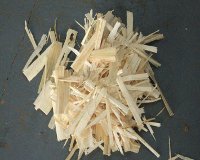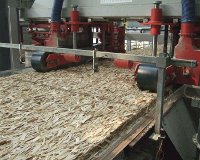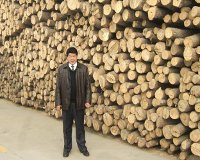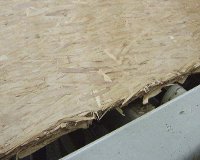Another good year’s sales
17 May 2012The markets in 2011 outside North America continued strong, making it the third year in succession in which producers have sold every board they could produce. Prices remain under pressure while costs continue to rise. However, new capacity in a country new to OSB manufacturing – Russia – is the main news
Sales volumes in the largest-volume panel products markets of MDF and particleboard are not bringing smiles to the faces of the producers, but fortunately there is something to smile about elsewhere.
European manufacturers of OSB, when interviewed about the markets in 2011, were all very upbeat, just as they were about 2009 and 2010.
Understanding why this particular panel product is doing so well is rather difficult, with no producer able to say precisely why it thinks demand has remained buoyant for the past three years, when the global economy has been in such difficulties.
Of course it is not all undiluted good news.
The cost of wood, resin, energy, etc continues to rise and producers have all found it difficult to achieve lasting price increases to cover these additional expenses. While several of them achieved price rises early on in 2011, it proved impossible for most to maintain them as the year unfolded.
Then there is the continuing problem of wood supply/price as subsidies continue to be paid to the energy generators that burn wood which could be used to make panels.
Another possible cloud on the horizon concerns the proliferation of new capacity coming up in eastern Europe and the effect this may have on supply and demand for the western European producers. It is generally considered/hoped that markets for this new capacity will be fairly local to the producers.
In a conversation with Norbord, which has its OSB mill in Scotland, we came back to the vexed subject of biomass energy generation. This is an issue which has seen quite a bit of attention in the UK in the past year, including a hard-hitting public awareness campaign led by the Wood Panel Industries Federation, which represents the UK's panel producers.
"We've had a year-long battle on biomass and it is a very big threat to our industry," said the Norbord spokesman. "The government has no knowledge of forestry/biomass issues and doesn't realise that we would need three times the stock of wood in the UK to feed the proposed plants. That will mean a lot of imports.
"There was a massive public outcry when the UK government tried to sell off the forest, so maybe we would get a similar reaction if they knew about biomass [issues].
"The European continent's position is just as bad and older particleboard and MDF mills are starting to close because of wood supply issues," he added.
He went on to describe Norbord UK's OSB business as "remarkably good" in 2011.
"Consumption per capita is still relatively low in the UK and OSB hasn't replaced plywood to the extent that it should have and there is still a lot of low-grade plywood being imported by dubious importing companies.
"The industry needs to extend the market penetration of OSB. In the UK, builders prefer [rubbish] plywood and still none of them seem to get prosecuted [for using sub-standard board]."
The spokesman went on to say that Norbord's UK mill - and its mill in Genk, Belgium - both produced flat out in 2011 and were still doing so in early 2012. The company is looking at productivity improvements in areas such as resin technology. In fact, he said, the European arm of Norbord is making a major contribution to parent Norbord Inc's lacklustre results as it struggles to make money in the North American market.
In common with other producers, Norbord in Europe found that it managed to increase prices for its OSB at the beginning of 2011, but price pressures built during the year and if the company was not to lose sales to its competitors, it had to be "flexible" on price.
Smartply (Coillte) in Ireland also had a successful 2011 in terms of volumes. Prices were raised in the earlier part of the year but, in common with the others, declined again towards the end, under competitive pressure.
Egger's mill in Wismar in northern Germany also produced to its full capacity in 2011 and, while the company feels the market will be challenging this year, it is quietly confident. An exhibition on roofing and timber frame housing, held in Stuttgart in early 2012 and attended by Egger, had a good number of visitors and left the company with good expectations of positive business development.
Egger is in fact one of those companies mentioned earlier in terms of expansion in eastern Europe. The company's new mill in Radauti, Romania produced its first panel on November 16, 2011 and has been in more or less continuous production ever since, apart from a short adjustment period, said a spokesman.
"Since the beginning of this year, we have produced continuously there and we are seeing good demand from eastern Europe in particular." Addressing the concerns of others about possible over-capacity, he said: "Temporarily there may be a period of oversupply but historically new capacity opens new doors for new business opportunities".
It is envisaged that the Radauti mill will produce 300,000m3 in 2012, with capacity for an increase to 350,000m3 "at some point".
Main production volumes will be in OSB3 grade, with some OSB2 going to southeastern European markets. The factory is employing an E1 resin system, whereas Wismar uses full pMDI gluing and also produces OSB4, mainly for central European markets. Up to 40% of Wismar's production is in OSB4.
"We are actively promoting OSB and supporting our customers in finding new applications," said the spokesman. "It takes time but looking back, we have been successful in new applications - and in substituting other products - and this will continue in the future. There is a lot of volume that could be replaced."
Egger Wismar's prices were also raised in early 2011, but lost some ground in the second half.
The biomass issue is taking its toll here too. "It is about the availability of the right wood in the right amount. Our feeling is that nobody is listening when biomass energy is being promoted by the highest level of government, even though there have been complaints from the lower [regional] levels. Sometimes there is a shortage of material and therefore a price problem. Plus the rising oil costs of course."
Egger is optimistic so far for sales in 2012, but admitted the market is hard to predict with the global economic situation, Greece's economic woes and so on, making the crystal ball a little cloudy.
One of the smaller-capacity European mills is that of Kronolux in Luxembourg, but it did manage to grow a little in 2011.
Having postponed a 5% capacity increase in 2010, the company did carry out the modifications in 2011, raising capacity from 200,000 to 210,000m3. This was achieved by 'tweaking' of the existing line, which has a Siempelkamp eight-daylight hot press.
Being one of the smaller producers, Kronolux defines its place in the market by making speciality products as well as more 'normal' specifications.
Again, this company tried to increase prices, with some success early in the year, but with prices falling back later on in a market in which supply and demand were in balance, making increases difficult to hold.
"Our costs are increasing, especially for energy, and timber prices are already on a high level - any further increase would be dramatic for us," said a spokesman.
In Luxembourg too, biomass is an issue and while no projects have yet been realised, it is already "talking up the price" of wood.
"Nobody knows how the new [OSB] capacity coming on stream will affect the market," said the spokesman. "We are talking about 40-50,000m3-a-month continuous lines, not small capacities. Four or five years ago I could predict at least six months ahead - now it's difficult to predict two months!"
He believes prices for OSB, in his markets at least, will at best stabilise in 2012.
Kronotex of Heiligengrabe, Germany, took a four-week downtime in production in April 2011, rather than its normal week or 10 days' annual maintenance stoppage, to upgrade its OSB line.
With a considerable investment, the company increased the line's annual capacity from a previous maximum of 400,000m3 to 435,000-438,000m3. The figure of 420,000m3 that we published in last year's survey was apparently over-stated and the true figure was between 386,000 and 400,000m3.
The upgrade involved improvements to the hydraulics of the Siempelkamp ContiRoll continuous press, as well as improvements to the heating of the press platens.
"We made a lot of other smaller detail changes in the line, from woodyard all the way through, producing this big step up in production capacity," said a spokesman.
The line was restarted at the end of April and test-run before ramping up to its full, new, capacity by July.
This new capacity is shown in the listings for 2011 as the company claims to have produced and sold 430,000m3.
In terms of price, the story was familiar: "If we say end-2010 was 100%, then the first eight months of last year was 115%," said the spokesman in February. "However, in the last four months of 2011, prices decreased slightly month-by-month and now we are back more or less to that 100%. There was some aggressive competition."
He added that so far in 2012, the market was more or less the same as in 2011 (though without the price increase). "At the moment, all the information we are getting from our markets is promising," he said.
Kronotex has also obtained orders to supply OSB further afield to China, Australia and South Africa as new markets. Volumes to the latter two countries are currently modest, but Kronotex sees step-by-step growth there.
Although the Chinese market is 80% OSB2 grade, the spokesman said his company only supplied OSB3 and that some Chinese customers were prepared to pay for that. Heiligengrabe ceased production of OSB2 over two years ago, although its sister mills in Sully, France (Kronofrance) and Zary, Poland (Kronopol) can offer OSB2.
Fire retardant (FR) OSB is also produced in Zary and stocked in Germany and France. It is a niche product which sells about 300-500m3 a month between the three plants.
"We have German building certification for FR and in the past four months we have had more and more enquiries for it but it will always be a niche product," said the spokesman. He said he thought Heiligengrabe's wood costs were maybe very slightly lower at the beginning of this year. Supply contracts are long-term and the mill knows it has enough wood for 2012.
However, he said he had to be thinking about a price increase on OSB from April 1st 2012. "We have to fight every day to get a higher price but at this moment it is not possible. Maybe we will get a second increase in early Autumn."
Glunz of Meppen, Germany, also reported a very good year in 2011 and felt that 2012 may be harder as the mill exports to eastern Europe to some extent and will face new competition in those markets. However, most of Meppen's sales are in western Europe and most commentators think that the eastern European board will not come into the west in significant quantities.
Glunz produces all pMDI-throughout board in OSB2,3 & 4, but the spokesman pointed out that now that EN1052 states that OSB3 is OK for all construction purposes, demand for OSB4 may reduce.
The company managed to increase its prices in 2011, but only to cover increased costs and it continues to concentrate on its higher-grade products OSB3 and 4, which command higher prices than OSB2.
The spokesman expressed some concern about the new capacity coming from Russia from lines which employ the same continuous press technology as the west European mills. The Russian mills also generally have a good wood supply close by.
So far, German quality has won the day in western Europe, but the fear is that this could possibly change as the new plants come on stream with high quality board.
Future capacity development
Egger's new line in Romania, as stated earlier, is in full production for 2012, with a further 50,000m3 to be added "at some point".
In Turkey, SFC Entegre Orman Urünleri San Tic AS of Kastamonu (Kronospan-owned) started up its 150,000m3 line during 2011 (anticipated at 170,000m3 in last year's survey). We have left it in future mills as it was not in full production throughout 2011.
Kastamonu Entegre of Turkey is planning an OSB mill in Gorno Sahrane, Bulgaria, under the name of its subsidiary Gabrovnitsa AD, for start-up in January 2016 (480,000m3).
Kastamonu Entegre is also planning a mill in Russia, in Alabuga, Tatarstan, planned to start up in January 2019 (480,000m3).
The suppliers of the main equipment for these two projects had not yet been decided as we went to press.
Again in Russia, the OOO Borea UPMKymmene/Sveza Group joint venture in Sheksna, South Vologda, mentioned in last year's report (WBPI Issue 2, 2011, p24) as a possibility has now been dropped. The feasibility study was completed and the partners are said to be considering the next steps for a wood industry complex there. However, UPM confirmed that OSB is no longer part of those plans.
Also in Russia, the OOO DOK Kalevala OSB mill in Petrozawodsk, Karelia is destined to make its first board of phase 1 around week 30 (July) this year. We are still not aware of a date for phase 2.
Bubbling under the surface is another new project, this time for LPK Partner-Tomsk, one of Russia's largest MDF producers. The company is planning a €150m development and hopes to have the mill onstream in 2014. Currently, negotiations are still ongoing with Siempelkamp and Dieffenbacher over the supply of the continuous press and other components of the line.
Again in Russia, the line mentioned in last year's survey as being planned by Safwood of Italy for a 376,000m3 capacity in the Komi Republic in 2012 is now 'dead in the water' as Safwood allegedly got into severe financial/legal difficulties.
Another Russian line listed in last year's report and news pages was that of Cherepovets Plywood and Furniture and Vologda Lumberers. It was supposed to come on stream with 250,000m3 annual capacity in 2013 and another 250,000m3 in 2017/18 and seemed to be a firm proposition.
However, this year we can find no information on this project at all. We would be very pleased to hear from anyone who can shed light on this one.
Meanwhile, ORIS LLC should be producing 500,000m3/year on its new line in the Perm region from the end of 2012, on a Dieffenbacher CPS line.
On its multi-line site in Egorievsk, near Moscow, Kronospan is setting up a secondhand line originally from Grant Forest Products, Timmins, Ontario. This is a Siempelkamp ContiRoll with a capacity believed to be around 350,000m3/year.
As reported last year, the PDVSA/CVG proposed Dieffenbacher continuous line in Venezuela is still indefinitely suspended.
China is apparently showing no further interest in large-scale OSB plants since the inauguration of the Baoyuan plant in 2010.
There are serious question marks over the market demand for OSB in China.
There is however a small-scale pilot line utilising bamboo, which started production in September 2011 in Luxi, Yunnan province. It is owned by Yunglifa Forest Ltd and we will carry a full report on this mill in WBPI soon.
All the added and coming capacity in eastern Europe is an unknown to some extent, in terms of market effect. Western producers hope the new capacity will serve mainly local markets but that is to assume those markets aren't already being supplied by western mills and that there is indeed new demand.
As one western European producer said "I am confident that the European market overall will increase with time but in the short term we could need some 'balancing downtime', as we have had in the past, to even out the supply and avoid a fall in price [due to over-capacity]."
If we add all the planned/possibly planned new capacity for the rest of the world together, it comes to an additional 3,560,000m3, excluding the suspended Venezuela project; and the Cherepovets 500,000m3 project which may not happen.
Even so, we can expect an additional 3.3 million m3 in the next seven years or so, and all in 'greater Europe'.
Latin America
The advance of OSB in Latin America's Southern Cone continues from strength to strength, reports WBPI's correspondent Richard Higgs, with the sub-continent's chief supplier, Louisiana Pacific, reporting its 2011 regional sales up 16%.
Still leading the charge is Chile, where widespread post-earthquake reconstruction has boosted already-strong demand. LP's two local OSB mills are running flat out and the vibrant national market is sucking in additional board from the US and Brazil.
Louisiana Pacific's concerted campaign to promote wood frame housebuilding is making real progress in Chile where LP estimates this system accounts for more than half of all home construction.
In Brazil, where the economy continues to grow strongly, LP reports it is gradually chipping away at building regulations to win consent for wider use of OSB products in home construction.
Last year saw LP Brasil achieve volume growth of some 30% as its single 350,000m3/year OSB mill at Ponta Grossa increased output to almost 60% of capacity.
Its continuous Dieffenbacher line, formerly run jointly with the Chilean group Masisa, actually exported 20% of its production to China for decorative interior applications during 2011.
But repeating the Chilean formula and achieving a breakthrough with wood frame building techniques in Brazil has been more of an uphill struggle for LP. The process has been much slower, largely on account of the 'jungle' of regulatory red tape the group has encountered in the construction sector.
Rather than following the Chilean path of direct 'conversion' to wood frame construction, LP Brasil now has a strategy of seeking ways to integrate OSB by adapting Brazil's existing building practices.
Applications aimed at introducing the board include its use in interior walls, roof and floor systems, according to LP.
"The regulatory environment in Brazil is very different from other countries in the sense that you have to get these things approved one at a time and then the builders themselves have to get them approved," the US group's specialities sales executive, vice president Richard S Olszewski, told financial analysts in February.
The OSB message is evidently getting through as the firm doubled the number of 'dealers' promoting the board nationally to over 50 last year.
Working piecemeal, LP Brasil has won "six or seven key approvals in the past 12 months", reported Mr Olszewski, who added that LP Brasil is still working on several other potential approvals.
The group appears close to a real breakthrough in Brazil in the construction area, working on securing two major projects: one in social housing and the other in the private sector, representing "a significant number of homes".
"This will be our big breakthrough when we're able to achieve that, which we expect to do in 2012," revealed the executive vice president.
Masisa and LP have already developed a growing domestic market for OSB outside the specific wood frame technology segment, with applications in heavy duty packaging, fencing materials, concrete form and other non-frame construction uses.
Growth in these areas has come as LP Brasil expanded the number of OSB sales outlets in other parts of South America's biggest country to 500 last year.
The big challenge for LP in South America remains how to build up additional profitable OSB business in Brazil to utilise its available capacity at Ponta Grossa, according to group CEO Rick Frost.
LP is likely to continue building volume output in Brazil this year both in Chinese exports and with domestic customers. The group expects to increase the home market and to make a decision in 2012 on the use of its additional capacity.
The group is already on record as planning, longer-term, to invest in a second OSB mill in Brazil which it aims to focus on speciality product manufacture, leaving the sizeable Ponta Grossa line to handle volume demand.
There is little doubt that, with its growing population and vibrant economy, Brazil will provide an argument for adding new OSB capacity soon. The need for more board will be even greater as the BRIC nation builds up its infrastructure ready to host both the Olympic Games and the football World Cup.
In Chile, LP has two batch-production OSB mills based on used equipment shipped from the US, with an original mill in Panguipulli with a 120,000m3/year capacity and a second plant in Lautaro with a capacity of 150,000m3/year.
The region is now a very significant part of the group's overall business and for the first time this year has merited a separate segment in its annual results report.
That is a symbol of LP's dogged determination and increasing success in selling the OSB concept to Latin America.



